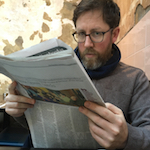25 years on: How the Angel of the North put its north-east home town on the map

It’s striking how much can change in the course of a successful project. When Gateshead Council first approached sculptor Sir Antony Gormley with the idea of creating a landmark sculpture overlooking the A1, to put the north-eastern town on the cultural map, he wasn’t exactly enthralled.
“I don’t make art for motorways,” he thought. Yet Gormley would later describe the finished iconic piece far more positively: “An extraordinary collective effort, requiring thousands of conversations… The Angel was made by the skills of the north-east.”
Now celebrating its 25th birthday, the Angel of the North is one of APM’s 50 Projects For a Better Future. Made from Cor-ten steel, it stands 20m tall on the site of an old colliery, welcoming people with the spread of its wings, which have a span that matches that of a jumbo jet.
Gateshead Council wanted a sculpture that would get the town noticed on the global arts scene. But Gormley’s vision also delivered a huge engineering challenge. Responsibility fell to Ove Arup, which had to ensure the structure was safe while facing winds of more than 100mph.
But according to John Thornton, then Arup’s Project Director for the Angel project, that wasn’t where the main issues lay.
“You just do some sums based on the weight and factor in the wind,” he told The Guardian in a 2016 retrospective. “It was the ankles that were hard. They had to be slim, even though that’s where all the stress is… When the wind is blowing on a human being, you move constantly to compensate. Obviously, we couldn’t do that here, so we had to think carefully about how to make them strong enough.”
Its wings were the second major challenge: flexing would be fine, but if they began to flutter, the structure would be destroyed.
Thornton recalled how Gormley’s initial drafts featured wings that tapered like those of Spitfire, in contrast to the chopped ends of the iconic finished version. So how easy was it for the project to balance the artist’s vision with those practicalities?
“Working with an artist is a challenge,” says Neil Carstairs, the Arup team leader for the bulk of the detailed design phase. “But we had a very good manager on the fabricator side. If the artist proposed something ridiculous, the manager didn't fly off the handle or just say no. He’d go away and think, and then come back proposing something that wasn't the impossible thing the artist was asking for, but that did give him what he was looking for.”
On the evening of Valentine’s Day in 1998, the Angel’s components rolled out of the fabricator’s Hartlepool HQ in a convoy of trucks and travelled the 28 miles to the site. The piece was erected there the next day, in front of a crowd of thousands.
For Thornton, seeing a 500-tonne crane lower the Angel on to the 52 three-metre bolts that secured it to the ground “felt like a religious experience”.
Gateshead Council must have felt similar. Having successfully brought the Angel project home within its £800,000 budget, the council was then able to redevelop the quayside into a cultural quarter, with the Baltic Centre for Contemporary Art and the Gateshead Millennium Bridge, which won the Sterling Prize for Architecture in 2002.
“It was an achievement everyone was very proud of,” says Carstairs. “It went down so well with the public and definitely put Gateshead on the map.”
In his 2016 interview with The Guardian, Thornton shared his personal reaction, which will surely resonate with managers of other successful engineering projects that have helped shape the cultural landscape of the country:
“Whenever I pass it, I think: ‘That’s nice; I did that’,” he said.


0 comments
Log in to post a comment, or create an account if you don't have one already.